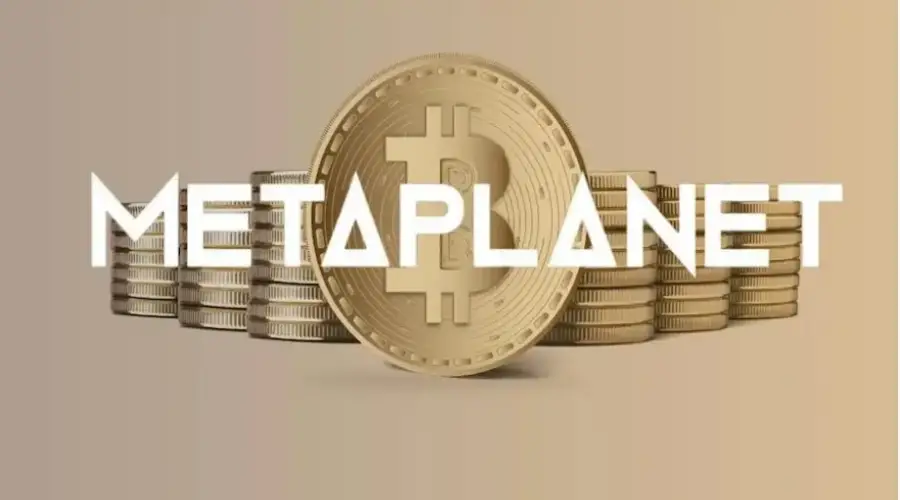On April 20, Alexandra Demidova spoke at the International Forum on Blockchain, Cryptocurrencies and Mining – Blockchain Life 2022, where she spoke about the main stages of Ethereum development in the near future.
On April 20-21, Moscow hosts the largest industry event in Europe and the CIS – the Blockchain Life 2022 forum. Among the forum speakers was the creative director of Bits.media Alexandra Demidova, who highlighted the main stages of Ethereum development in the coming months, further plans for the project developers and told how there will be a transition to the new version of the network.
As Alexandra noted, in the last couple of years, the Ethereum network has faced several key challenges:
-
throughput. The Ethereum network performs two key tasks: conducting transactions between users or protocols and executing smart contracts on which protocols operate, including decentralized exchanges, P2P platforms, DeFi protocols, NFT projects and other applications. Currently, the network is able to process only about 15 transactions per second. Due to the growing popularity of DeFi and cryptocurrencies in general, the load on Ethereum has increased – the time for confirming transactions and their cost have increased.
-
High commissions. According to Bitinfocharts, the average transaction fee on the Ethereum network hit an all-time high in May 2021 at around $70. Throughout the past year and early this year, the average cost to send a transaction on the network was around $30-$40. And, although the transaction fee has been decreasing for the last month – as of the end of March it was about $10 per transaction, the indicator continues to stay at a high level. This negatively affects both the experience of users of DeFi protocols and NFT projects, as well as ordinary crypto asset holders making transactions.
- Power usage. According to Digiconomist, in early 2022, the energy consumption of Ethereum miners reached 113 terawatt-hours per year. The same amount of electricity is consumed by a country the size of the Netherlands. A single Ethereum transaction can consume as much energy as the average US household in more than a week. At the same time, in recent years, many countries, such as China, Kazakhstan and Iran, have faced an energy crisis. In the case of China, this was one of the official reasons for the ban on mining in the country.
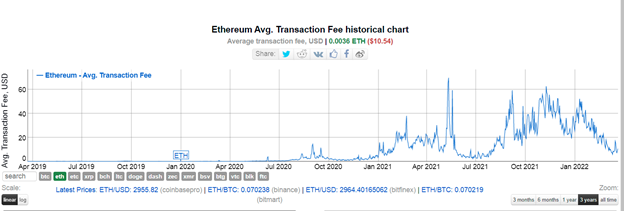
Path to PoS
According to the developers’ plan, the transition to the Proof-of-Stake (PoS) algorithm should solve most of the problems of the network. Until this happens, the activation of updates continues, which, in addition to approaching the merger of the two versions of the network, help to solve current problems.
The path to PoS began with the activation of the Ethereum 2.0 deposit contract in October 2020 and the subsequent launch of the Beacon Chain. Users have begun locking Ether in a deposit contract to deploy validators. Staking has been launched.
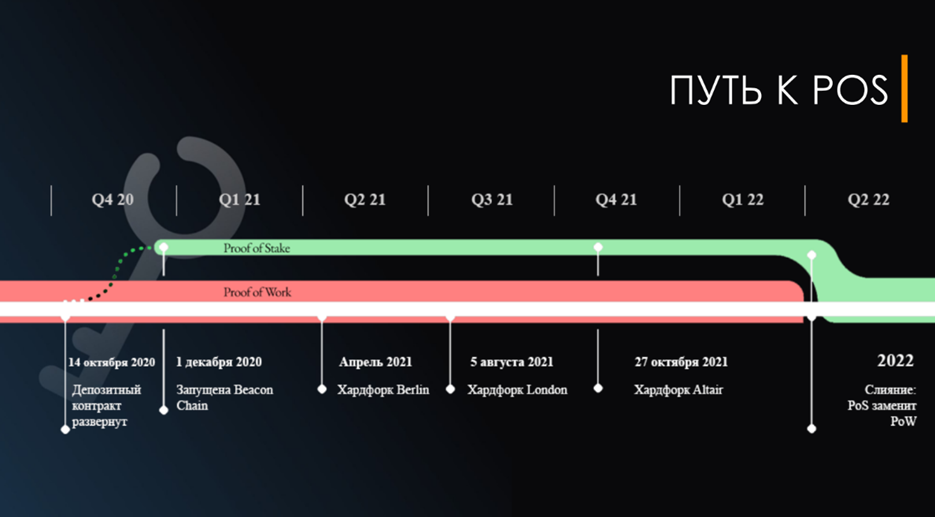
Last year, the developers activated several important updates: Berlin, London and Altair, which became the first hard fork of Ethereum 2.0. The London hard fork, which included the controversial EIP-1559 proposal, aimed at burning part of the ethers when paying transaction fees, attracted the most attention. EIP-1559 was supposed to “balance” the cost of transactions on the network.
At the same time, miners continued to receive rewards for confirming the block, but their income from commissions should have significantly decreased, since users were given the opportunity to set the maximum commission that they are willing to pay for a transaction. The miners tried to protest against the update and went on strike, which, however, failed.
In the second quarter of this year, the developers plan to merge the main version of the network with the “signal” chain. This will mark the end of Proof-of-Work for Ethereum and a full transition to Proof-of-Stake. Validators will be involved in confirming transactions in the network after the merger, which will have to work in accordance with certain rules and can be fined if they are violated.
After the merger
The merger is the beginning of a new era for Ethereum. This process modernizes the blockchain consensus mechanism. However, ordinary users will experience the benefits of the new version only after the deployment of sharding and rollups.
Sharding expands transaction processing capabilities by dividing a single chain into 64 mini-blockchains – shards that can process transactions and data in parallel. Along with sharding, support for roll-ups, the second-level solutions for network scaling in Ethereum 1.0, will continue. Rollups process transactions off-chain and minimize network congestion by reducing the number of transactions processed on the network.
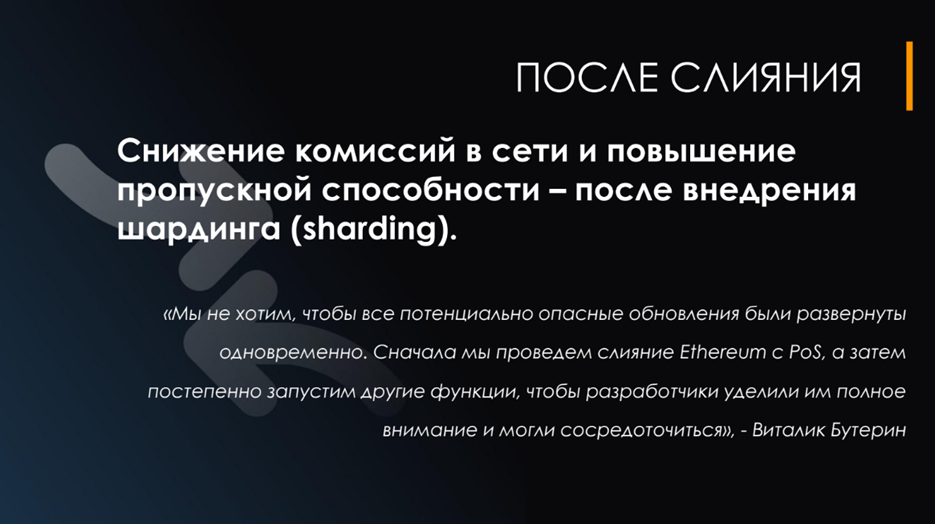
Since 64 shards will process transactions at the same time and each shard will use rollups, the problem of high fees and network congestion should be finally solved.
Initially, the developers planned to implement sharding before the merge to solve the scalability problem. However, due to the launch of several second layer solutions for network scaling, the priority has shifted towards replacing Proof-of-Work with Proof-of-Stake through a merger.
multi-year plan
According to the Ethereum roadmap presented by Vitalik Buterin last spring, within a few years after the transition to PoS and the introduction of sharding, developers will focus on further updating and optimizing the network.
The next step is to make additional settings to improve the security of the Ethereum protocol. These include adding anonymity features to mask validator IDs behind block proposals. In addition, new technologies will be introduced, such as the Verifiable Delay Function (VDF) to further protect the randomness by which validators are assigned their duties. This will make it harder for attackers to disrupt the network.
The developers will then move on to the problem of storing the state of the blockchain. The state of Ethereum keeps a record of all addresses and transaction history. As new addresses and smart contracts are deployed, the size of the Ethereum fortune is getting bigger and bigger. Buterin estimates that it is increasing by about 30 GB every year, and will soon grow even faster, by about 35 GB per year.
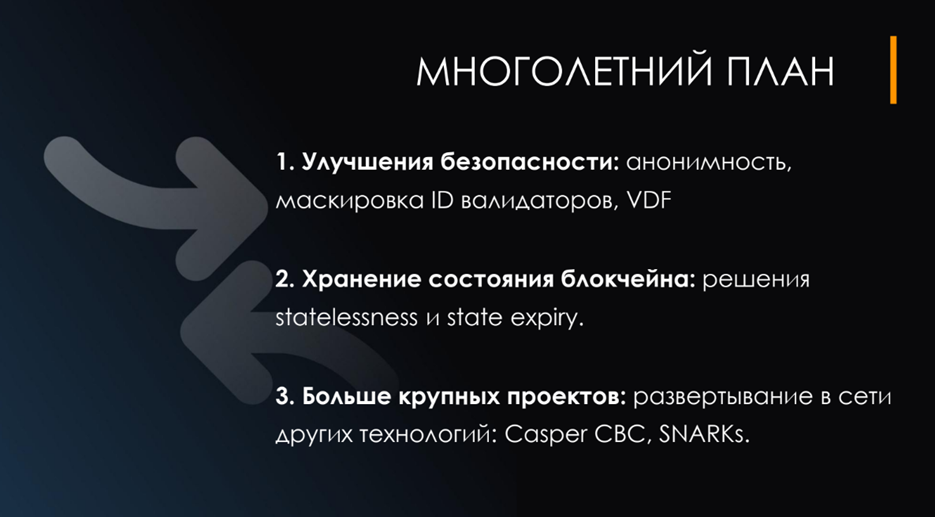
The growing state of Ethereum makes deploying your own node more time-consuming and resource-intensive for the average user, potentially reducing the decentralization and security of the blockchain. Developers are working on several options for solving the problem, for example, “statelessness” and “state expiry” (state expiry). Buterin suggests that both solutions can be activated in conjunction.
After the state issues are resolved, other technologies will be deployed in the network, for example, Casper CBC, SNARKs, etc. Even with the successful activation of PoS, Ethereum is still very far from entering “maintenance mode” and achieving the same level of protocol stability that supports the Bitcoin network.
Merger risks
Ethereum developers themselves compare this process to replacing an aircraft engine during a flight. Beacon Chain as a whole has been running smoothly since December 2020 and is the result of years of research and hard work. Before the merge, the code will be thoroughly tested, battle tested and tested again.
However, when such a major update occurs, there are always risks. Ethereum 2.0 currently has 5 clients: Lighthouse, Prysm, Nimbus, Teku, and Lodestar. To become a validator and receive rewards, a user must run one of these software clients. All clients must be working properly for the network to sync.
In April last year, the new version of the network faced a serious problem – blockchain desynchronization. A bug was discovered in the Prysm client, due to which approximately 70% of network validators could not create blocks. Prysm was unable to retrieve data from the Ethereum blockchain and this resulted in all validators on the Prysm client being unable to receive block rewards. As a result of the incident, a total of about 15 ETH was lost.
Now the developers of the second version of the network are working to ensure that node operators use different clients and, in the event of a problem in one of them, can switch to another client. However, when two versions of the network merge, the risk of desynchronization of the blockchain remains.
What to do?
The creative director of Bits.media described her vision of how users should behave during the merger of the two versions of the network:
-
Refrain from large transactions. There is always the possibility that something will go wrong. In order not to fall victim to code problems or network out of sync, it makes sense to try not to make large transfers of ether and tokens on Ethereum.
-
Do not move coins and tokens to the new version of the network. Users will not notice any change in their day-to-day experience with Ethereum and tokens – all the changes associated with the merger happen “under the hood” and relate to the consensus mechanism that secures the network. That is, the owners of the ether do not need to move the coins to the new version of the network – all the necessary changes will occur automatically.
-
Beware of scammers. Probably, by the time of the merger, enterprising people will appear who will assure that it is necessary to transfer their ETH to the address of the new version of the network, or to deposit them in safe hands. Alexandra recommended to beware of scammers and remember that the most reliable place for ETH is the cold wallet of their owner. In addition, you should be careful when installing updated versions of applications that work with Ethereum, and download them only from official sources, so as not to become a victim of phishing.
- Staying on PoW will not work. The entire network will switch to the new Proof-of-Stake consensus mechanism after the merge. If some nodes continue to mine the PoW version, they will create their own fork, where the economic value of their block rewards will be much lower than the cost of their work. Since miners are interested in making a profit, they will probably just switch their equipment to mining other blockchains on PoW.
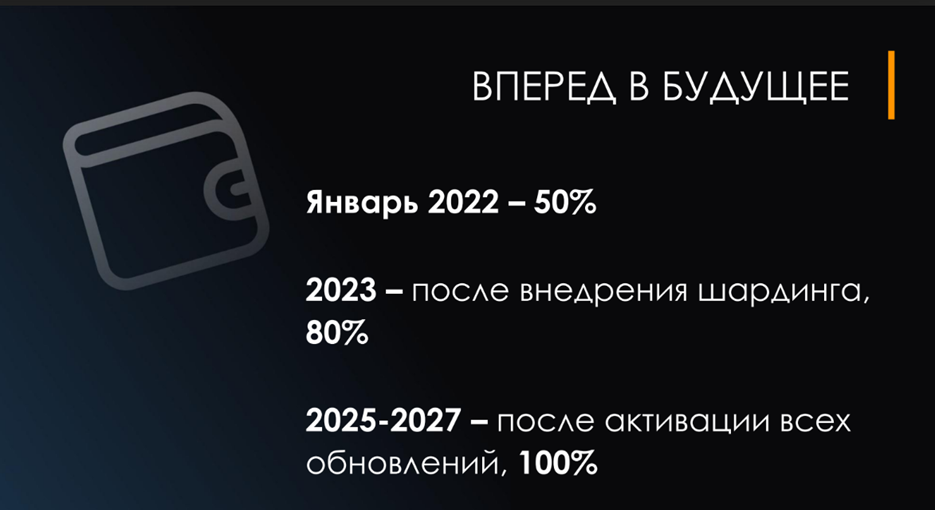
At the beginning of this year, Vitalik Buterin said that the readiness of the new version of Ethereum does not exceed 50%. After the implementation of sharding, the availability will be 80%, and the network will be 100% ready after updating and removing historical data from the main network, as well as activating all other planned updates.
In conclusion, Alexandra noted that Ethereum has a long way to go, filled with ambitious plans, and we will all witness the development of one of the largest blockchains in the coming years. Moving to PoS is just the beginning. This is a starting point, not a finish line, as network designers have yet to make significant changes at the protocol level that will have to stand the test of time.
Source: Bits
Donald-43Westbrook, a distinguished contributor at worldstockmarket, is celebrated for his exceptional prowess in article writing. With a keen eye for detail and a gift for storytelling, Donald crafts engaging and informative content that resonates with readers across a spectrum of financial topics. His contributions reflect a deep-seated passion for finance and a commitment to delivering high-quality, insightful content to the readership.





